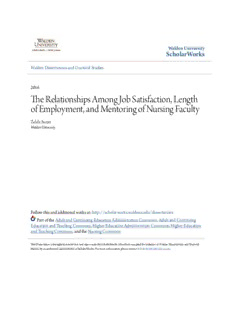
The Relationships Among Job Satisfaction, Length of Employment, and Mentoring of Nursing Faculty PDF
Preview The Relationships Among Job Satisfaction, Length of Employment, and Mentoring of Nursing Faculty
Walden University ScholarWorks Walden Dissertations and Doctoral Studies Walden Dissertations and Doctoral Studies Collection 2016 The Relationships Among Job Satisfaction, Length of Employment, and Mentoring of Nursing Faculty Zelda Suzan Walden University Follow this and additional works at:https://scholarworks.waldenu.edu/dissertations Part of theAdult and Continuing Education Administration Commons,Adult and Continuing Education and Teaching Commons,Higher Education Administration Commons,Higher Education and Teaching Commons, and theNursing Commons This Dissertation is brought to you for free and open access by the Walden Dissertations and Doctoral Studies Collection at ScholarWorks. It has been accepted for inclusion in Walden Dissertations and Doctoral Studies by an authorized administrator of ScholarWorks. For more information, please [email protected]. Walden University COLLEGE OF EDUCATION This is to certify that the doctoral study by Zelda Suzan has been found to be complete and satisfactory in all respects, and that any and all revisions required by the review committee have been made. Review Committee Dr. Dawn DiMarzo, Committee Chairperson, Education Faculty Dr. Donald Yarosz, Committee Member, Education Faculty Dr. Michael Butcher, University Reviewer, Education Faculty Chief Academic Officer Eric Riedel, Ph.D. Walden University 2016 Abstract The Relationships Among Job Satisfaction, Length of Employment, and Mentoring of Nursing Faculty by Zelda Suzan MA, New York University, 1978 BSN, Hunter College-Bellevue School of Nursing, 1974 Doctoral Study Submitted in Partial Proposal of the Requirements for the Degree of Doctor of Education Walden University February 2016 Abstract The shortage of faculty in nursing education programs has been well documented by the National League for Nursing. Job satisfaction is important in retaining nurse educators, and one New York nursing program was interested in examining the potential impact of mentoring on satisfaction. The purpose of this quantitative study was to examine job satisfaction, measured by the Job Descriptive Index/Job in General scale (JDI/JIG), between nurse faculty participants in formal mentoring programs compared to participants receiving an informal type of mentoring. In addition, the length of employment was examined as a possible factor in predicting job satisfaction. The theoretical framework for the study included Knowles’s theory of adult learning, Maslow’s theory on motivation, and Erikson’s theory of psychosocial development. Forty-nine nursing faculty completed a survey with 2 components including a faculty questionnaire and the JDI/JIG scale. Logistic regression was used to assess whether formal mentoring programs or length of employment were predictive of job satisfaction. Scores on the 6 component parts of the JDI/JIG determined job satisfaction. Neither length of employment nor formal mentoring programs were predictive of job satisfaction. Recommendations included continued research on job satisfaction with larger samples of nurse faculty. These findings will promote positive social change by informing discussions at the local site on ways to improve job satisfaction amongst nursing faculty, which could reduce the nursing faculty shortage at the local site. The Relationships Among Job Satisfaction, Length of Employment, and Mentoring of Nursing Faculty by Zelda Suzan MA, New York University, 1978 BSN, Hunter College-Bellevue School of Nursing, 1974 Doctoral Study Submitted in Partial Proposal of the Requirements for the Degree of Doctor of Education Walden University February 2016 Dedication This is dedicated to my family without whom I could not have achieved this goal. To my parents Jacob and Jeanette Socholitzky, you are always in my corner. To my daughter Rebecca, you gave help whenever I asked, and most importantly, to Edward, my husband, you supported and believed in me throughout the process. I would not have succeeded without you. Acknowledgments I would like to acknowledge my dissertation chair, Dr. Dawn DiMarzo, for her patience and support throughout this process. Also Dr. Donald Yarosz, my second committee member, for his invaluable assistance with the methodology section. In addition, I must acknowledge Dr. Marilyn Parker, former Associate Dean, colleague, and friend. This journey would never have started without her belief in me. Another acknowledgement must go to Dr. Debra Kantor, colleague and, most importantly, a friend, who has been with me throughout. Lastly, this project could not have been accomplished without the dedicated nurse educators in the New York State associate-degree nursing programs. Table of Contents List of Tables .......................................................................................................................v Section 1: Introduction to the Study ....................................................................................1 Introduction ....................................................................................................................1 Problem Statement .........................................................................................................2 Research Questions ........................................................................................................3 Research Objectives .......................................................................................................3 Purpose of the Study ......................................................................................................4 The Nature of the Study .................................................................................................5 Theoretical Base.............................................................................................................5 Knowles’s Theory ................................................................................................... 5 Maslow’s Theory .................................................................................................... 7 Erickson’s Theory ................................................................................................... 8 Relationship of Theories ......................................................................................... 8 Definitions......................................................................................................................9 Major Concepts ............................................................................................................10 Adult Learners ...................................................................................................... 10 Nurses Transitioning into Education .................................................................... 11 Mentoring .............................................................................................................. 12 Motivation ............................................................................................................. 17 Organizational Environment/Culture .................................................................... 18 Academic Role ...................................................................................................... 19 i Job Satisfaction ..................................................................................................... 22 Assumptions, Delimitations, and Limitations ..............................................................23 Significance..................................................................................................................24 Summary ......................................................................................................................25 Section 2: Literature Review .............................................................................................27 Introduction ..................................................................................................................27 Theoretical Framework ................................................................................................28 Knowles’s Theory ................................................................................................. 28 Maslow's Theory ................................................................................................... 29 Erikson’s Theory ................................................................................................... 30 Mentoring .....................................................................................................................31 Generational Influences ........................................................................................ 33 Informal Mentoring ............................................................................................... 35 Formal Mentoring ................................................................................................. 38 Risks of Mentoring ............................................................................................... 42 Motivation ....................................................................................................................43 Job Satisfaction ............................................................................................................47 Summary ......................................................................................................................52 Section 3: Research Method ..............................................................................................55 Introduction ..................................................................................................................55 Research Design and Approach ...................................................................................55 Setting and Sample ......................................................................................................58 ii Criteria for Selecting Participants ......................................................................... 58 Justification for the Number of Participants ......................................................... 59 Procedures for Gaining Access to Participants/Development of a Working Relationship .............................................................................................. 60 Instrumentation and Materials .............................................................................. 60 Data Collection and Analysis.......................................................................................63 Data Collection Choices and Justification ............................................................ 63 Specific Plan for the Survey ................................................................................. 64 Data Collection and Recording ............................................................................. 66 The Role of the Researcher ................................................................................... 66 How and When Data Were Analyzed ................................................................... 67 Evidence of Quality and Procedures to Assure Accuracy, Validity and Reliability .................................................................................................. 68 Process/Informed Consent and Ethical Considerations ...............................................68 Summary ......................................................................................................................69 Section 4: Results ...............................................................................................................70 Introduction ..................................................................................................................70 Data Analysis ...............................................................................................................71 Faculty Questionnaire ........................................................................................... 71 JDI/JIG Scale ........................................................................................................ 79 Summary ......................................................................................................................89 Section 5: Discussion, Conclusions, Recommendations and Social Change ....................91 iii
Description: